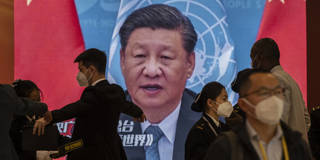Top-down decisions, often implemented by competent technocrats, have enabled China to build high-quality infrastructure and achieve rapid economic growth. But President Xi Jinping’s handling of the COVID-19 crisis and his erratic decision-making have highlighted the flaws in China’s one-party regime.
NEW YORK – Until fairly recently, Chinese President Xi Jinping touted his zero-COVID policy as proof that authoritarian one-party states like China are better equipped to deal with pandemics (or any other crisis) than messy democracies hampered by selfish politicians and fickle electorates.
This might have seemed plausible to many in 2020, when hundreds of thousands of Americans were dying and former US President Donald Trump was touting antimalaria drugs and bleach injections as COVID-19 remedies. Meanwhile, Xi enforced rigid pandemic restrictions that almost shut down the entire country, forced people into isolation camps, and insisted that Chinese citizens traveling abroad wear hazmat suits, like workers in some giant toxic laboratory. For a while, this strict regime appeared to keep COVID deaths to a minimum, compared to most other countries (though Chinese government statistics are notoriously unreliable).
But the high economic costs of China’s zero-COVID strategy drove people to such despair that some finally took to the streets, at great risk. Still, Xi continued to claim that the ruling Communist Party was waging a “people’s war” against the virus and would do whatever it takes to save lives. Then, at the end of last year, when protests erupted across Chinese cities, the war was suddenly declared over. No more lockdowns, hazmat suits, or even regular PCR tests. Following last year’s unprecedented protests, it appears that China now deems COVID-19 harmless.

NEW YORK – Until fairly recently, Chinese President Xi Jinping touted his zero-COVID policy as proof that authoritarian one-party states like China are better equipped to deal with pandemics (or any other crisis) than messy democracies hampered by selfish politicians and fickle electorates.
This might have seemed plausible to many in 2020, when hundreds of thousands of Americans were dying and former US President Donald Trump was touting antimalaria drugs and bleach injections as COVID-19 remedies. Meanwhile, Xi enforced rigid pandemic restrictions that almost shut down the entire country, forced people into isolation camps, and insisted that Chinese citizens traveling abroad wear hazmat suits, like workers in some giant toxic laboratory. For a while, this strict regime appeared to keep COVID deaths to a minimum, compared to most other countries (though Chinese government statistics are notoriously unreliable).
But the high economic costs of China’s zero-COVID strategy drove people to such despair that some finally took to the streets, at great risk. Still, Xi continued to claim that the ruling Communist Party was waging a “people’s war” against the virus and would do whatever it takes to save lives. Then, at the end of last year, when protests erupted across Chinese cities, the war was suddenly declared over. No more lockdowns, hazmat suits, or even regular PCR tests. Following last year’s unprecedented protests, it appears that China now deems COVID-19 harmless.